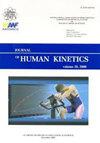Sex Differences in Heart Rate Variability and Vascular Function Following High-Intensity Interval Training in Young Adults
IF 1.9
3区 医学
Q2 SPORT SCIENCES
引用次数: 0
Abstract
High-intensity interval training (HIIT) is superior to other training strategies in both male and female healthy individuals. Understanding sex-specific differences in cardiac auto-regulation may contribute to the optimal training strategies for HIIT. The present study aimed to identify sex differences in heart rate variability (HRV) and vascular function following HIIT in young adults. Twenty-four physically active young male and female adults (M: 12, F: 12, age: 19.5 yr, BMI: 22.1 kg∙m−2) volunteered to participate in the study. Participants performed 10 bouts of HIIT including 20 s of high-intensity cycling at 115–130% Wmax followed by 100 s of recovery. The cardiac auto-regulations including HRV and vascular function were measured at five different time points. The R-R interval, rMSSD, and SDNN were recovered faster in males than in females after 15 min of HIIT. There were sex differences in the autonomic nervous system where ln LF and ln HF activities along with sympathovagal balance (ln LF/HF) were greater in females compared with males immediately and 15 min after HIIT. However, no significant differences in blood pressure and brachial-ankle pulse wave velocity were observed between male and female participants. Overall, HRV was more activated in females than in males following HIIT, but the acute response in vascular function was not different between sexes. In future studies, sex-specific adaptations of cardiac auto regulation following repeated HIIT may need to be performed.年轻人高强度间歇训练后心率变异性和血管功能的性别差异
在男性和女性健康个体中,高强度间歇训练(HIIT)优于其他训练策略。了解心脏自动调节的性别差异可能有助于HIIT的最佳训练策略。本研究旨在确定年轻人HIIT后心率变异性(HRV)和血管功能的性别差异。24名身体活跃的年轻男性和女性成人(男:12岁,女:12岁,年龄:19.5岁,BMI: 22.1 kg∙M−2)自愿参加了这项研究。参与者进行了10次HIIT,包括20秒的高强度运动,在115-130% Wmax下进行,然后进行100秒的恢复。在5个不同时间点测量心率变异和血管功能等心脏自动调节功能。HIIT 15 min后,男性的R-R间期、rMSSD和SDNN恢复速度快于女性。自主神经系统存在性别差异,女性的lnlf和lnhf活动以及交感迷走神经平衡(lnlf /HF)在HIIT后立即和15分钟高于男性。然而,在男性和女性参与者之间没有观察到血压和臂踝脉搏波速度的显著差异。总体而言,HIIT后HRV在女性中比男性更活跃,但血管功能的急性反应在性别之间没有差异。在未来的研究中,重复HIIT后心脏自动调节的性别特异性适应可能需要进行。
本文章由计算机程序翻译,如有差异,请以英文原文为准。
求助全文
约1分钟内获得全文
求助全文
来源期刊

Journal of Human Kinetics
医学-运动科学
CiteScore
4.80
自引率
0.00%
发文量
83
审稿时长
3 months
期刊介绍:
The Journal of Human Kinetics is an open access interdisciplinary periodical offering the latest research in the science of human movement studies. This comprehensive professional journal features articles and research notes encompassing such topic areas as: Kinesiology, Exercise Physiology and Nutrition, Sports Training and Behavioural Sciences in Sport, but especially considering elite and competitive aspects of sport.
The journal publishes original papers, invited reviews, short communications and letters to the Editors. Manuscripts submitted to the journal must contain novel data on theoretical or experimental research or on practical applications in the field of sport sciences.
The Journal of Human Kinetics is published in March, June, September and December.
We encourage scientists from around the world to submit their papers to our periodical.
 求助内容:
求助内容: 应助结果提醒方式:
应助结果提醒方式:


